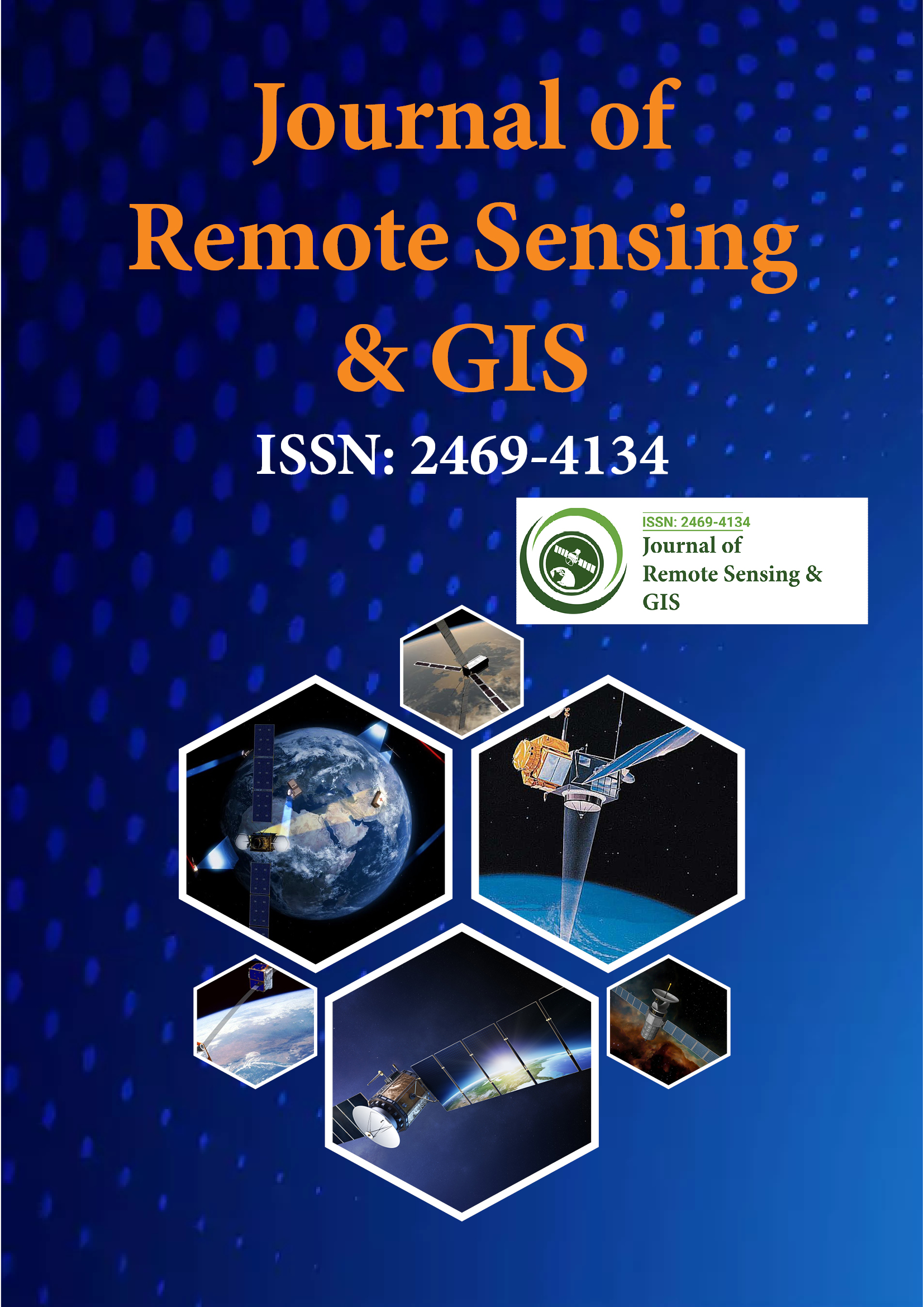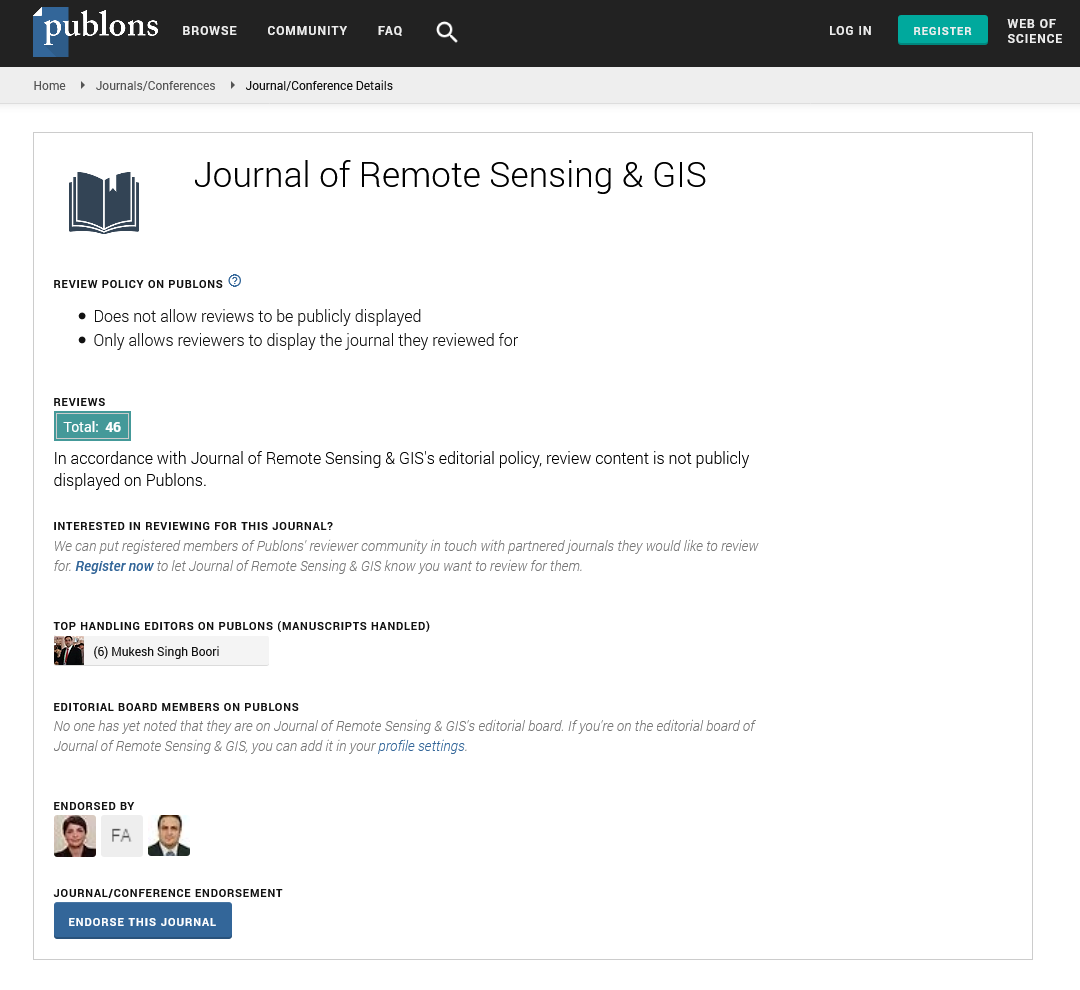Indexed In
- Open J Gate
- RefSeek
- Hamdard University
- EBSCO A-Z
- OCLC- WorldCat
- Publons
- International Scientific Indexing
- Euro Pub
- Google Scholar
Useful Links
Share This Page
Journal Flyer

Open Access Journals
- Agri and Aquaculture
- Biochemistry
- Bioinformatics & Systems Biology
- Business & Management
- Chemistry
- Clinical Sciences
- Engineering
- Food & Nutrition
- General Science
- Genetics & Molecular Biology
- Immunology & Microbiology
- Medical Sciences
- Neuroscience & Psychology
- Nursing & Health Care
- Pharmaceutical Sciences
Commentary - (2024) Volume 13, Issue 4
Remote Sensing in Climate Science: A Tool for Global Monitoring and Analysis
Jane Limon*Received: 25-Nov-2024, Manuscript No. JGRS-24-28060; Editor assigned: 27-Nov-2024, Pre QC No. JGRS-24-28060 (PQ); Reviewed: 12-Dec-2024, QC No. JGRS-24-28060; Revised: 20-Dec-2024, Manuscript No. JGRS-24-28060 (R); Published: 27-Dec-2024, DOI: 10.35248/2469-4134.24.13.361
Description
Climate change presents one of the most significant challenges of the modern era. Its impact spans across various environmental, social and economic sectors, making effective monitoring and assessment essential for informing policy decisions and mitigating its effects. Remote sensing technology has emerged as an important tool in climate change research, capacity to monitor, assess and predict environmental changes on a global scale. Through satellite imagery, aerial surveys and other sensing techniques, remote sensing enables scientists and policymakers to gather comprehensive data on the earth’s climate system, track trends and make informed decisions.
Remote sensing refers to the collection of information about an object or phenomenon without making physical contact. This technology uses sensors to detect electromagnetic radiation reflected or emitted from the earth’s surface. These sensors are mounted on satellites, aircraft, or ground-based platforms and are capable of capturing data across various wavelengths of light, including visible, infrared and microwave bands. Remote sensing provides a detailed, large-scale view of the Earth’s surface, allowing for the monitoring of environmental variables that are critical for understanding climate change.
Key applications of remote sensing in climate change monitoring
Remote sensing applications in climate change monitoring are:
Temperature monitoring and heat Islands: One of the most direct indicators of climate change is the rise in global temperatures. Remote sensing technology plays an important role in tracking temperature fluctuations across different regions. Thermal infrared sensors on satellites can capture surface temperature variations, allowing scientists to observe both global warming trends and local temperature changes, such as urban heat islands. By analyzing these temperature patterns over time, remote sensing provides essential data on temperature anomalies, helping to understand how climate change is influencing regional and local climates.
Monitoring greenhouse gas emissions: Greenhouse Gases (GHGs), such as Carbon dioxide (CO2), Methane (CH4) and Nitrous oxide (N2O), are major contributors to climate change. Remote sensing enables the monitoring of these gases through satellite-based instruments that measure their concentration in the atmosphere. For example, NASA’s OCO-2 (Orbiting Carbon Observatory) satellite provides high-resolution measurements of CO2 levels, helping to track carbon emissions at both global and regional scales. Additionally, remote sensing aids in detecting methane leaks from natural gas infrastructure, contributing to more accurate emission inventories and improved climate change assessments.
Vegetation and carbon sequestration: Vegetation plays an important role in carbon sequestration, acting as a natural carbon sink by absorbing CO2 from the atmosphere. Remote sensing technologies, such as multispectral and hyperspectral imaging, allow scientists to monitor vegetation cover, health and changes in land use. By analyzing vegetation indices, such as the Normalized Difference Vegetation Index (NDVI), remote sensing helps to quantify changes in carbon storage potential over time. This data is essential for understanding the role of forests, grasslands and other ecosystems in mitigating climate change and for tracking the impact of deforestation and land degradation.
Sea level rise and coastal erosion: Rising sea levels, a direct consequence of global warming, significant risks to coastal communities and ecosystems. Remote sensing technology provides invaluable data for monitoring sea level changes and coastal erosion. Satellites such as the European Space Agency’s CryoSat-2 and NASA’s ICESat-2 measure changes in the height of the earth’s surface, including sea level variations. Additionally, remote sensing data helps to monitor changes in coastal ecosystems, such as mangroves, coral reefs and wetlands, which are particularly vulnerable to rising sea levels and climate- related changes in ocean temperatures.
Extreme weather events: Climate change is linked to an increase in the frequency and intensity of extreme weather events, such as hurricanes, floods, droughts and wildfires. Remote sensing technology plays a key role in tracking these events, providing real-time data for assessing their impacts and guiding emergency response efforts. For example, satellites with radar and optical sensors are used to monitor rainfall, soil moisture and flood extents, enabling scientists to track and predict flooding events. Similarly, remote sensing is crucial for monitoring wildfire activity by detecting changes in vegetation and assessing fire damage.
Conclusion
Remote sensing technology is playing an important role in the monitoring and assessment of climate change. By providing large-scale, accurate and timely data on a wide range of climate indicators, remote sensing enhances our understanding of the Earth’s changing climate system. While challenges remain in data accuracy and integration, the continued advancement of remote sensing technology, coupled with emerging data analysis techniques, with high potential for improving climate change monitoring and informing global mitigation and adaptation strategies. As climate change continues to pose significant threats to ecosystems and human societies, remote sensing will remain a fundamental tool for a sustainable future.
Citation: Limon J (2024). Remote Sensing in Climate Science: A Tool for Global Monitoring and Analysis. J Remote Sens GIS. 13:361.
Copyright: © 2024 Limon J. This is an open-access article distributed under the terms of the Creative Commons Attribution License, which permits unrestricted use, distribution and reproduction in any medium, provided the original author and source are credited.

